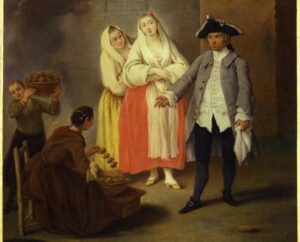
“Boccon da poareti e da siori,” that’s how the fritoleri used to describe them.
The Venetian frittelle, or fritoe venexiane, are among the most eagerly awaited sweets during Carnival time, loved by both adults and children alike.
Everyone enjoys them, thanks to their variety of fillings: chocolate, ricotta, pistachio, or simply plain, alla venexiana (with pine nuts and raisins mixed into the dough and covered in sugar).
They are fried and absolutely delicious!
Even today, you can find them at the stalls of the fritoleri, the frittelle vendors, scattered throughout the city and in the most famous areas where masks and artists gather for Carnival.
But how did frittelle originate in Venice?
They were born in the mid-14th century, and the original recipe is preserved in Rome at the Museo Nazionale Canatese.
Later, they became the national dessert of the Serenissima Republic in the 1700s.
There are various written records preserved at the State Archives near the Church of the Frari, in the square of the same name.
According to texts from the time, the historical recipe included lard instead of oil, goat’s milk, and saffron (imported from the East) added to the dough.
Today, frittelle can also be found in pastry shops throughout the city; whereas back then, they were prepared in the streets by the fritoleri in small wooden huts (caselli) and sold hot.
In the 1600s, the fritoleri organized themselves into an association, composed of seventy members, each assigned an exclusive area to conduct their trade, with the guarantee that only their children could inherit the business through an official license: it was a true family tradition.
This corporation remained active until the fall of the Venetian Republic, although the art of the fritoleri only truly disappeared from the calli of Venice by the end of the 19th century.

Historians recount that the fritoleri used to knead frittelle—made with eggs, flour, sugar, raisins, and pine nuts—on large wooden tables.
They would then fry them in oil or lard, using huge pans supported by tripods.
Once ready, the frittelle were sprinkled with sugar and arranged on large decorated plates; next to them, on other plates, the ingredients were displayed in full view to emphasize the authenticity of the product.
Throughout the Veneto region, local variations of frittelle spread, involving fruit dipped in batter, flowers, vegetables, and in some cases even wild herbs from fields and mountains, as well as rice and polenta.
The “fritola” even influenced Jewish cuisine, which created a special version for Purim.
The Venetian frittelle have an important historical testimony in a famous painting by Pietro Longhi from the 18th century, The Frittelle Seller, exhibited at Ca’ Rezzonico.
In the painting, the donut-shaped frittelle are cooked and served skewered on a stick, allowing them to be eaten while strolling through the city’s calli.
Here is a perfect example of Venetian street food that you absolutely must try!